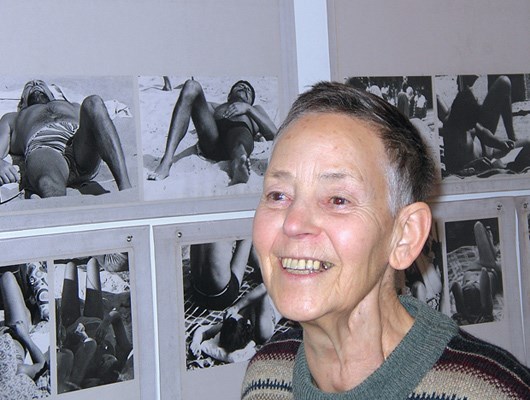Anna Oppermann: Filiations / Andrea Pinheiro: Bomb Book / Marianne We Let's Take Back Our Space at Presentation House Gallery, Jan. 19-March 24. For more details visit presentationhousegallery.org.
THE men sit with their legs apart, leaning forward with their forearms resting just above their knees. The women sit perfectly straight, their hands resting on their laps, legs pressed primly together as though the schoolmarm was passing behind them, ruler in hand.
On the other side of the gallery, an atomic detonation is recalled with the turn of each page. And in yet another space a cluster of photographic reproductions cling together like shards of a shattered mirror.
Beginning Saturday, the Presentation House Gallery is scheduled to house three distinct works by female artists whose fascinations, ranging from the nature of art, the artifice of gender, and the legacy of apocalyptic technology, border on the obsessive.
Standing in her socks amid hundreds of her photographs arranged on the gallery floor, Marianne Wex recalls the first time she picked up a camera.
"I was never really into photography. I was into painting," Wex recalls. Determined to understand body language to aid in her real artwork, Wex lugged her heavy Japanese camera into train stations and down city streets, where she would feign interest in the surrounding architecture to capture the unconscious body language of her real subjects.
Approximately 9,000 photographs later, Wex has built a body of work that playfully traces gestures, posture and movement from Greek and Egyptian sculpture through magazine glamour shots and her own street photographs.
After developing the first 500 photos in her bathtub, Wex began to note differences in the body language of men and women.
The German artist made it a point to mimic everyone she photographed, experimenting with different ways of moving and standing.
"I imitated whatever I found . . . I got to know myself," she says, a cheery smile on her face as she notes the masculine posture of a woman in a centuries-old sculpture.
Her work received some acclaim, but after a poor packing job led to the water damage that destroyed five pounds worth of her photographs, Wex broke from the art world.
"Then I was really forgotten," she says. That period of forgetfulness ended in 2009 when her work caught the attention of a London gallery curator. Over the last four years, Wex's work has been resurrected.
"I thought, 'call it what you want to. I find it interesting,'" Wex says.
"It's still relevant, and it's an interesting use of the camera and how she organized it into an archive," says Helga Pakasaar, curator at Presentation House Gallery. "This project is a very interesting documentary study, it's almost like sociology - she's really working through the evidence she found and structuring it in very interesting ways to make this point about patriarchal society."
The gallery is also featuring Andrea Pinheiro, the researcher behind Bomb Book, a minimalist record of every nuclear bomb detonation since 1945.
Pinheiro, a teacher at Algoma University in Ontario, is known for her photography, but this book contains no images, merely names.
"She spent many many years researching this area," Pakasaar says, discussing Pinheiro's 2,450 page book. "She's really part of a generation of artists who are . . . contributing to knowledge that otherwise wouldn't exist."
The name of one bomb is written on each page, and if the name is not known, the page is left blank.
"Even though she often works with photography, it's significant that she chose not to produce any images," Pakasaar says.
Photographs of atomic detonations are generally stirring, a giant fireball underneath a halo of smoke, the explosion painting everything in its radius a shade of deep crimson.
"Certainly what I've seen of atomic photography is quite sublime," Pakasaar says. "I think she decided that she wanted to record or make known what had occurred without falling subject to the difficulties of the beauty of making images of that."
The gallery is also exhibiting the work of Anna Oppermann, a painter and photographer known for installations that resemble an obsessive chaos on first inspection.
"I think I felt a bit overwhelmed," Pakasaar says, recalling her first encounter with Oppermann's work. "In many ways she was anticipating this interactive mode where you're forced into thinking 'Did I just see that or was that in another permutation?' She very intentionally sets up an initial impression that is slightly . . . destabilizing."
Once immersed in Oppermann's nest of photographs, paper scraps, notes, and drawings, the result can be enriching, according to Pakasaar.
"She puts you into a state of wanting to discover something," the curator says.
While each exhibit is distinct within the gallery, there is a bond between the artists, according to Pakasaar.
"They share an investigative approach," Pakasaar says. "There's kind of a sense of abundance and excess in what they make."



